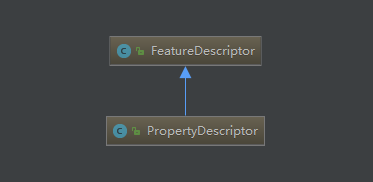关于属性描述符PropertyDescriptor
本文首发于本博客 猫叔的博客 ,转载请申明出处
前言
感谢GY丶L粉丝的提问:属性描述器PropertyDescriptor是干嘛用的?
本来我也没有仔细了解过 描述符 这一块的知识,不过粉丝问了,我就抽周末的时间看看,顺便学习一下,粉丝问的刚好是PropertyDescriptor这个属性描述符,我看了下源码。
/**
* A PropertyDescriptor describes one property that a Java Bean
* exports via a pair of accessor methods.
*/
public class PropertyDescriptor extends FeatureDescriptor {
//...
}
emmmm,假装自己英语能厉害的说,属性描述符描述了一个属性,即Java Bean 通过一对访问器方法来导出。(没错,他确实是存在于java.beans包下的)

通过类关系图,可以知道,我们应该提前了解一下 FeatureDescriptor 才行了。很好,起码目前还没有设计抽象类或者接口。
FeatureDescriptor
/**
* The FeatureDescriptor class is the common baseclass for PropertyDescriptor,
* EventSetDescriptor, and MethodDescriptor, etc.
* <p>
* It supports some common information that can be set and retrieved for
* any of the introspection descriptors.
* <p>
* In addition it provides an extension mechanism so that arbitrary
* attribute/value pairs can be associated with a design feature.
*/
public class FeatureDescriptor {
//...
}
okay,这是很合理的设计方式,FeatureDescriptor为类似PropertyDescriptor、EvebtSetDescriptor、MethodDescriptor的描述符提供了一些共用的常量信息。同时它也提供一个扩展功能,方便任意属性或键值对可以于设计功能相关联。
这里简单的说下,在我大致看了一下源码后(可能不够详细,最近有点忙,时间较赶),FeatureDescriptor主要是针对一下属性的一些get/set,同时这些属性都是基本通用于PropertyDescriptor、EvebtSetDescriptor、MethodDescriptor。
private boolean expert; // 专有
private boolean hidden; // 隐藏
private boolean preferred; // 首选
private String shortDescription; //简单说明
private String name; // 编程名称
private String displayName; //本地名称
private Hashtable<String, Object> table; // 属性表
其实该类还有另外几个方法,比如深奥的构造函数等等,这里就不深入探讨了。
PropertyDescriptor
那么我们大致知道了 FeatureDescriptor ,接下来就可以来深入了解看看这个属性描述符 PropertyDescriptor 。
说到属性,大家一定会想到的就是get/set这个些基础的东西,当我打开 PropertyDescriptor 源码的时候,我也看到了一开始猜想的点。
private final MethodRef readMethodRef = new MethodRef();
private final MethodRef writeMethodRef = new MethodRef();
private String writeMethodName;
private String readMethodName;
这里的代码是我从源码中抽离的一部分,起码我们这样看可以大致理解,是分为写和读的步骤,那么就和我们初学java的get/set是一致的。
同时我还看到了,这个,及其注释。
// The base name of the method name which will be prefixed with the
// read and write method. If name == "foo" then the baseName is "Foo"
private String baseName;
这好像可以解释,为什么我们的属性在生成get/set的时候,第一个字母变成大写?!注释好像确实是这样写的。
由于可能需要一个Bean对象,所以我以前在案例中先创建了一个 Cat 类。
public class Cat {
private String name;
private String describe;
private int age;
private int weight;
public String getName() {
return name;
}
public void setName(String name) {
this.name = name;
}
public String getDescribe() {
return describe;
}
public void setDescribe(String describe) {
this.describe = describe;
}
public int getAge() {
return age;
}
public void setAge(int age) {
this.age = age;
}
public int getWeight() {
return weight;
}
public void setWeight(int weight) {
this.weight = weight;
}
}
构造函数
起码目前,我还不知道我应该怎么使用它,那么我们就一步一步来吧,我看到它有好几个构造函数,这是一个有趣而且有难度的事情,我们先试着创建一个 PropertyDescriptor 吧。
- 第一种构造函数
/**
* Constructs a PropertyDescriptor for a property that follows
* the standard Java convention by having getFoo and setFoo
* accessor methods. Thus if the argument name is "fred", it will
* assume that the writer method is "setFred" and the reader method
* is "getFred" (or "isFred" for a boolean property). Note that the
* property name should start with a lower case character, which will
* be capitalized in the method names.
*
* @param propertyName The programmatic name of the property.
* @param beanClass The Class object for the target bean. For
* example sun.beans.OurButton.class.
* @exception IntrospectionException if an exception occurs during
* introspection.
*/
public PropertyDescriptor(String propertyName, Class<?> beanClass)
throws IntrospectionException {
this(propertyName, beanClass,
Introspector.IS_PREFIX + NameGenerator.capitalize(propertyName),
Introspector.SET_PREFIX + NameGenerator.capitalize(propertyName));
}
这个好像是参数最少的,它只需要我们传入一个属性字符串,还有对应的类就好了,其实它也是调用了另一个构造函数,只是它会帮我们默认生成读方法和写方法。方法中的 Introspector.IS_PREFIX + NameGenerator.capitalize(propertyName) 其实就是自己拼出一个默认的get/set方法,大家有兴趣可以去看看源码。
那么对应的实现内容,我想大家应该都想到了。
public static void main(String[] args) throws Exception {
PropertyDescriptor CatPropertyOfName = new PropertyDescriptor("name", Cat.class);
System.out.println(CatPropertyOfName.getPropertyType());
System.out.println(CatPropertyOfName.getPropertyEditorClass());
System.out.println(CatPropertyOfName.getReadMethod());
System.out.println(CatPropertyOfName.getWriteMethod());
}
- 第二种构造函数
/**
* This constructor takes the name of a simple property, and method
* names for reading and writing the property.
*
* @param propertyName The programmatic name of the property.
* @param beanClass The Class object for the target bean. For
* example sun.beans.OurButton.class.
* @param readMethodName The name of the method used for reading the property
* value. May be null if the property is write-only.
* @param writeMethodName The name of the method used for writing the property
* value. May be null if the property is read-only.
* @exception IntrospectionException if an exception occurs during
* introspection.
*/
public PropertyDescriptor(String propertyName, Class<?> beanClass,
String readMethodName, String writeMethodName)
throws IntrospectionException {
if (beanClass == null) {
throw new IntrospectionException("Target Bean class is null");
}
if (propertyName == null || propertyName.length() == 0) {
throw new IntrospectionException("bad property name");
}
if ("".equals(readMethodName) || "".equals(writeMethodName)) {
throw new IntrospectionException("read or write method name should not be the empty string");
}
setName(propertyName);
setClass0(beanClass);
this.readMethodName = readMethodName;
if (readMethodName != null && getReadMethod() == null) {
throw new IntrospectionException("Method not found: " + readMethodName);
}
this.writeMethodName = writeMethodName;
if (writeMethodName != null && getWriteMethod() == null) {
throw new IntrospectionException("Method not found: " + writeMethodName);
}
// If this class or one of its base classes allow PropertyChangeListener,
// then we assume that any properties we discover are "bound".
// See Introspector.getTargetPropertyInfo() method.
Class[] args = { PropertyChangeListener.class };
this.bound = null != Introspector.findMethod(beanClass, "addPropertyChangeListener", args.length, args);
}
没错,这个构造函数就是第一种构造函数内部二次调用的,所需要的参数很简单,同时我也希望大家可以借鉴这个方法中的一些检测方式。这次的实现方式也是同样的形式。
public static void main(String[] args) throws Exception {
PropertyDescriptor CatPropertyOfName = new PropertyDescriptor("name", Cat.class,"getName","setName");
System.out.println(CatPropertyOfName.getPropertyType());
System.out.println(CatPropertyOfName.getPropertyEditorClass());
System.out.println(CatPropertyOfName.getReadMethod());
System.out.println(CatPropertyOfName.getWriteMethod());
}
- 第三种构造函数
/**
* This constructor takes the name of a simple property, and Method
* objects for reading and writing the property.
*
* @param propertyName The programmatic name of the property.
* @param readMethod The method used for reading the property value.
* May be null if the property is write-only.
* @param writeMethod The method used for writing the property value.
* May be null if the property is read-only.
* @exception IntrospectionException if an exception occurs during
* introspection.
*/
public PropertyDescriptor(String propertyName, Method readMethod, Method writeMethod)
throws IntrospectionException {
if (propertyName == null || propertyName.length() == 0) {
throw new IntrospectionException("bad property name");
}
setName(propertyName);
setReadMethod(readMethod);
setWriteMethod(writeMethod);
}
这个不用传类,因为你需要传递两个实际的方法进来,所以主要三个对应属性的参数既可。看看大致的实现内容
public static void main(String[] args) throws Exception {
Class<?> classType = Cat.class;
Method CatNameOfRead = classType.getMethod("getName");
Method CatNameOfWrite = classType.getMethod("setName", String.class);
PropertyDescriptor CatPropertyOfName = new PropertyDescriptor("name", CatNameOfRead,CatNameOfWrite);
System.out.println(CatPropertyOfName.getPropertyType());
System.out.println(CatPropertyOfName.getPropertyEditorClass());
System.out.println(CatPropertyOfName.getReadMethod());
System.out.println(CatPropertyOfName.getWriteMethod());
}
好了,大致介绍了几种构造函数与实现方式,起码我们现在知道它需要什么。
一些使用方式
其实在我上面写一些构造函数的时候,我想大家应该已经感受到与反射相关了,起码我感觉上是这样的,所以我一开始想到这样的案例形式,通过反射与这个属性描述类去赋予我的类。
public static void main(String[] args) throws Exception {
//获取类
Class classType = Class.forName("com.example.demo.beans.Cat");
Object catObj = classType.newInstance();
//获取Name属性
PropertyDescriptor catPropertyOfName = new PropertyDescriptor("name",classType);
//得到对应的写方法
Method writeOfName = catPropertyOfName.getWriteMethod();
//将值赋进这个类中
writeOfName.invoke(catObj,"river");
Cat cat = (Cat)catObj;
System.out.println(cat.toString());
}
运行结果还是顺利的。
Cat{name='river', describe='null', age=0, weight=0}
可以看到,我们确实得到了一个理想中的对象。
那么我是不是可以改变一个已经创建的对象呢?
public static void main(String[] args) throws Exception {
//一开始的默认对象
Cat cat = new Cat("river","黑猫",2,4);
//获取name属性
PropertyDescriptor catPropertyOfName = new PropertyDescriptor("name",Cat.class);
//得到读方法
Method readMethod = catPropertyOfName.getReadMethod();
//获取属性值
String name = (String) readMethod.invoke(cat);
System.out.println("默认:" + name);
//得到写方法
Method writeMethod = catPropertyOfName.getWriteMethod();
//修改值
writeMethod.invoke(cat,"copy");
System.out.println("修改后:" + cat);
}
上面的demo是,我先创建了一个对象,然后通过属性描述符读取name值,再进行修改值,最后输出的对象的值也确实改变了。
默认:river
收尾
这是一个有趣的API,我想另外两个(EvebtSetDescriptor、MethodDescriptor)应该也差不多,大家可以再通过此方法去探究,只有自己尝试一次才能学到这里面的一些东西,还有一些项目场景的使用方式,不过一般的业务场景应该很少使用到这个API。那么这个东西究竟可以干什么呢?我想你试着敲一次也许有一些答案了。
公众号:Java猫说
现架构设计(码农)兼创业技术顾问,不羁平庸,热爱开源,杂谈程序人生与不定期干货。












![[HBLOG]公众号](https://www.liuhaihua.cn/img/qrcode_gzh.jpg)

